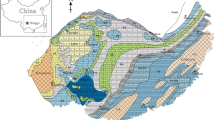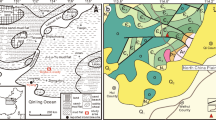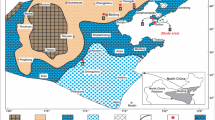Abstract
Ongoing microbialite formation is described at two previously unreported sites in southern Sinai, Egypt. Samples were collected in the peritidal tropical environment of Nabq Bay and Hidden Bay (southern Sinai, Egypt). Field observations and sample analyses show evidence of both sediment trapping and biostabilization in bacterial mucilaginous sheaths and microbially induced mineralization, producing a suite of increasingly lithified material: from agglomerated, consolidated sand to lithified crusts and oncoids. Thin-sections show evidence of bacteria (cyanobacteria and sulphate-reducing bacteria) among the constituent grains in the form of gelatinous filaments (green and red sheaths), and microalgal colonies along the outer edge, accompanied by a very high grade of clast alteration. The alternation of planar to irregular dark, superposed layers, and clastic layers is visible at the surface and/or inside some crusts. Widespread filaments of Schizothrix among grains have been identified, as well as extracellular polymeric substances (EPS), sheaths stabilizing particles, and calcareous tubular encrustations around cyanobacteria filaments. Carbonate precipitates include diffuse micrite, microcrystals of high-Mg calcite precipitating in the EPS matrix, and acicular aragonite as isopachous rims around grains. Cementation is accompanied by partial dissolution and progressive alteration of original grain boundaries. We describe four microbialite categories on the basis of their macroscopic morphology combined with different texture and lithification grade. The occurrence of the southern Sinai microbialites is explained by the interplay of local sedimentary dynamics and accommodation space in a peritidal tropical environment undergoing large temperature and salinity variations.





Similar content being viewed by others
References
Andres MS, Reid RP (2006) Growth morphologies of modern marine stromatolites: a case study from Highborne Cay, Bahamas. Sediment Geol 185:319–328
Aref MAM (1998) Holocene stromatolites and microbial laminites associated with lenticular gypsum in a marine-dominated environment, Ras El Shetan area, Gulf of Aqaba, Egypt. Sedimentology 45:245–262
Arp G, Thiel V, Reimer A, Michaelis W, Reitner J (1999) Biofilm exopolymers control microbialite formation at thermal springs discharging into the alkaline Pyramid Lake, Nevada, USA. Sediment Geol 126:159–176
Assaf G, Kessler J (1976) Climate and energy exchange in the Gulf of Aqaba (Eilat). Mon Weather Rev 104:381–385
Awramik SM, Margulis L (1974) Stromatolite Newsl 2:5
Baumgartner LK, Reid RP, Dupraz C, Decho AW, Buckley DH, Spear JR, Przekop KM, Visscher PT (2006) Sulfate-reducing bacteria in microbial mats: changing paradigms, new discoveries. Sediment Geol 185:131–145
Ben Avraham Z, Almagar G, Garfunkel Z (1979) Sediments and structure of the Gulf of Eilat (Aqaba) northern Red Sea. Sediment Geol 23:239–268
Black M (1933) The algal sedimentation of Andros Island Bahamas. Phil Trans R Soc Lond Ser B Biol Sci 222:165–192
Burne RV, Moore LS (1987) Microbialites: organosedimentary deposits of benthic microbial communities. Palaios 2:241–254
Cameron B, Cameron D, Jones JR (1985) Modern algal mats in intertidal and supratidal quartz sands, northeastern Massachusetts, USA. In: Curren HA (ed) Biogenic structures: their use in interpreting depositional environments. Soc Econ Paleont Miner Spec Publ 35:211–235
Davies DJ, Powell EN, Staff GM (1989) Relative rates of shell dissolution and net sedimentary accumulation—a commentary: can shell beds form by the gradual accumulation of biogenic debris on the sea floor? Lethaia 22:207–212
Dupraz C, Strasser A (1999) Microbialites and micro-encrusters in shallow coral bioherms (Middle-Late Oxfordian, Swiss Jura Mountains). Facies 40:101–130
Dupraz C, Visscher PT, Baumgartner LK, Reid RP (2004) Microbe-mineral interactions: early carbonate precipitation in a hypersaline lake (Eleuthera Island, Bahamas). Sedimentology 51:745–765
Dupraz C, Reid RP, Braissant O, Decho AW, Norman RS, Visscher PT (2009) Processes of carbonate precipitation in modern microbial mats. Earth Sci Rev 96:141–162
Friedman GM (1968) Geology and geochemistry of reefs, carbonate sediments, and waters, Gulf of Aqaba (Eilat), Red Sea. J Sediment Petrol 38:895–919
Friedman GM (2000) Formation of lithified micritic laminae in modern marine stromatolites: from study of Red Sea stromatolites: Perspective. Carbonat Ev 15:165–168
Friedman GM, Amiel AJ, Braun M, Miller DS (1973) Generation of carbonate particles and laminites in algal mats—example from sea-marginal hypersaline pool, Gulf of Aqaba, Red Sea. Am Assoc Petrol Geol Bull 57:541–557
Gerdes G, Klenke T, Noffke N (2000a) Microbial signatures in peritidal siliciclastic sediments: a catalogue. Sedimentology 47:279–308
Gerdes G, Krumbein WE, Noffke N (2000b) Evaporite microbial sediments. In: Riding R, Awramik SM (eds) Microbial sediments. Springer, Berlin Heidelberg New York, pp 96–208
Ginsburg RN (1991) Controversies about stromatolites: vices and virtues. In: Müller DW, McKenzie JA, Weissert H (eds) Controversies in modern geology. Academic Press, London, pp 25–36
Grotzinger JP, Knoll AH (1999) Stromatolites in Precambrian carbonates: evolutionary mileposts or environmental dipsticks? Ann Rev Earth Planet Sci 27:313–358
Hoffmann HJ (1969) Attributes of stromatolites. Geol Surv Can Pap 69:39–58
Hoffmann HJ (1973) Stromatolites: characteristics and utility. Earth Sci Rev 9:339–373
Kalkowsky E (1908) Oolith und Stromatolith im norddeutschen Buntsandstein. Z Dtsch Geol Ges 60:68–125
Konhauser K (2007) Introduction to geomicrobiology. Blackwell Science, London, p 425
Kühl M, Fenchel T, Kazmierczak J (2003) Growth, structure and calcification potential of an artificial cyanobacterial mat. In: Krumbein WE, Paterson DM, Zavarzin GA (eds) Fossil and recent biofilms, a natural history of life on earth. Kluwer Academic Publishers, Dordrecht, p 504
Logan BW, Hoffman P, Gebelein CD (1974) Algal mats, cryptalgal fabrics, and structures, Hamelin Pool, Western Australia. Am Assoc Petrol Geol Mem 22:140–194
Noffke N, Gerdes G, Klenke T (2003) Benthic cyanobacteria and their influence on the sedimentary dynamics of peritidal depositional systems (siliciclastic, evaporitic salty, and evaporitic carbonatic). Earth Sci Rev 62:163–176
Papineau D, Walker JJ, Mojzsis SJ, Pace NR (2005) Composition and structure of microbial communities from stromatolites of Hamelin Pool in Shark Bay, Western Australia. Appl Environ Microbiol 71:4822–4832
Paterson DM (1994) Microbiological mediation of sediment structure and behaviour. In: Stal LJ, Caumette P (eds) Microbial mats. Springer, Berlin Heidelberg New York, pp 97–109
Planavsky N, Ginsburg RN (2009) Taphonomy of modern marine Bahamian microbialites. Palaios 24:5–17
Raffi S, Serpagli E (1992) Introduzione alla paleontologia. UTET, Torino, p 654
Reid RP, Visscher PT, Decho AW, Stolz JF, Bebout BM, Dupraz C, Macintyre IG, Paerl HW, Pinckney JL, Prufert-Bebout L, Steppe TF, DesMarais DJ (2000) The role of microbes in accretion, lamination and early lithification of modern marine stromatolites. Nature 406:989–992
Reiss Z, Hottinger L (1984) The gulf of Aqaba—ecological micropaleontology. Ecol Stud 50:1–354
Riding R (1991) Classification of microbial carbonates. In: Riding R (ed) Calcareous algae and stromatolites. Springer, Berlin Heidelberg New York, pp 21–51
Riding R (1999) The term stromatolite: toward an essential definition. Lethaia 32:321–330
Riding R (2011a) Microbialites, stromatolites and thrombolites. In: Reitner J, Thiel V (eds) Encyclopedia of geobiology. Encyclop Earth Sci Ser. Springer, Berlin Heidelberg New York, pp 635–654
Riding R (2011b) The nature of stromatolites: 3,500 million years of history and a century of research. In: Reitner J, Quéric NV, Arp G (eds) Advances in stromatolite geobiology. Lecture notes in Earth Science 131:29–74
Riding R, Awramik SM (2000) Microbial sediments. Springer, Berlin Heidelberg New York, p 331
Semikhatov MA, Gebelein CD, Cloud P, Awramik SM, Benmore WC (1979) Stromatolite morphogenesis—progress and problems. Can J Earth Sci 16:992–1015
Spadafora A, Perri E, McKenzie JA, Vasconcelos C (2010) Microbial biomineralization processes forming modern Ca:Mg carbonate stromatolites. Sedimentology 57:27–40
Stal LJ, Van Gemerden H, Krumbein WE (1985) Structure and development of a benthic marine microbial mat. FEMS Microbiol Ecol 31:111–125
Tribollet A, Langdon C, Golubic S, Atkinson M (2006) Endolithic microflora are major primary producers in dead carbonate substrates of Hawaiian coral reefs. J Phycol 42:292–303
Van Lith Y, Warthmann R, Vasconcelos C, McKenzie JA (2003) Sulphate reducing bacteria induce low-temperature Ca-dolomite and high Mg-calcite formation. Geobiology 1:71–79
Visscher PT, Reid RP, Bebout BM (2000) Microscale observations of sulfate reduction: correlation of microbial activity with lithified micritic laminae in modern marine stromatolites. Geology 28:919–922
Vologdin AG (1962) The oldest algae of the USSR. Academy of Sciences of the USSR, Moscow, p 657
Walter MR (1972) Stromatolites and the biostratigraphy of the Australian Precambrian and Cambrian. Spec Pap Palaeont 11:1–190
Zingg T (1935) Beiträge zur Schotteranalyse. Schweiz Miner Petrol Mitt 15:39–140
Acknowledgments
Robert Riding and an anonymous referee are warmly acknowledged for the revision of the manuscript. The authors are grateful to The National Parks of Egypt, South Sinai Sector (NCS/EEAA), for field work permit. We thank P. Gentile for SEM imaging and L. Galimberti for her help in preparation of the petrographic thin-sections. Funds F.A.R. 2011 to DB from the University of Milano-Bicocca are gratefully acknowledged.
Author information
Authors and Affiliations
Corresponding author
Rights and permissions
About this article
Cite this article
Basso, D., Bracchi, V.A. & Favalli, A.N. Microbialite formation in southern Sinai (Egypt). Facies 59, 7–18 (2013). https://doi.org/10.1007/s10347-012-0330-4
Received:
Accepted:
Published:
Issue Date:
DOI: https://doi.org/10.1007/s10347-012-0330-4




